Abstract
The present study examined how “meaningful time ”is constructed and used during acrobatic performance. To do so, six elite athletes (2 tumblers, 2 trampolinists, 2 acrobatic skiers) performed the same acrobatic move within the context of their respective sports. Their activity was described step-by-step using the data obtained from self- confrontation interviews linked to behaviour analysis based on video recordings. The descriptions, which identified the actions, feelings and thoughts of the athletes in relation to the unfolding time of their performance, were then compared. The results demonstrated that acrobatic performance can be divided into different periods that delineate meaningful time. Differences were observed in how the athletes organized activity (e.g. cognitive, physical) according to the specific sport. The results were interpreted as specific ways to use flight time.
Key points.
Elite acrobatic athletes’ activities organize the unfolding of the performance by progressively informing the performers about the state of the evolving situation.
The complexity of the activity involved for such acrobatic performances is reduced by a process of timed and situated organization.
Athletes’ activity consisted to display different jigs corresponding to a meaningful delineate specious present for efficient performance.
Key words: Activity, meaningful time, situated cognition, acrobatic performance
Introduction
All human activity is made up of a series of specific actions that possess a finite time and duration. In sporting activities, the control of time seems to be one of the major components of athletic “efficiency”. During acrobatic sports such as gymnastics, high-diving and trampolining, athletes have to organize themselves within a narrow time frame to accomplish two goals: (a) the aesthetic performance of complex and multiple rotations and (b) the preparation of a balanced and safe landing. Indeed, several studies have demonstrated that elite athletes’ activity undergoes many adjustments during this time (Hauw et al., 2003; Hauw and Durand, 2004; 2007). The results of these latter studies are controversial in that they challenge the conception of performance as pre-programmed, and instead suggest that the athletes’ activity consists of constructing particular dynamics and is situated in “meaningful (ongoing) time ”in order to ensure an efficient performance. However, no study has yet investigated “meaningful time ”in different sports. Similar moves are performed by gymnasts, trampolinists and many freestylers, whereas the conditions for successful completion are quite different, particularly regarding flight time. The identification of different organizations of activity during the same acrobatic moves in different sports (e.g., trampolining, acrobatic skiing) would provide strong evidence about “meaningful time ”during performance.
Similar to the situated cognition framework (Greeno, 1998; Kirshner and Whitson, 1997), the ‘course-of-action’theory provides a means of studying activity at a level that is meaningful for the actor. A course-of-action may be defined as:
"the activity of a given actor engaged in a given physical and social environment belonging to a given culture, where the activity is meaningful for the actor; that is, he or she can show it, tell it, and comment upon it to an observer-listener at any moment during its unfolding ”(Theureau and Jeffroy, 1994, p. 19).
The course-of-action refers only to an autonomous level within the entire range of human activity, and course-of-action research thus does not claim to give an exhaustive account of activity. This analysis differs from motor control or biomechanical approaches because it focuses on the evolution of those actions, intentions or feelings that emerge during performance and are meaningful for athletes. The course-of-action theory has recently received considerable attention in elite sports research because it is well-suited to studying the stream of activity and its temporal dynamics (e.g., Hauw and Durand, 2005; 2007; Sève, 2004; Sève et al., 2003).
Based on the assumption that human activity is a dynamic process of co-determination between action and situation, the course-of-action theory focuses on the evolution of enacted meaning during performance (Bruner, 1990; Kirshner and Whitson, 1997). The theory assumes that this process, which is constructed by personal experience, can be studied at a pre-reflexive level (Theureau, 2003). This level can be reached using self-confrontation interviews, during which the actors are placed in a dynamic situation, face-to-face with the physical traces of their activity (in most cases, videotapes) and show, tell about, and comment on the episode they have experienced. In doing so, they reveal how they handled it in real time by building new meanings or activating pre-existing ones (Theureau, 1992; 2003).
The interviews make it possible to capture the organization of experience and inform researchers about the relationship of this organization to time as a performance is unfolding. Course-of-action theory relies on data that express experience derived from Peirce’s thought-sign model (1931-1935): (a) the “elementary units of meaning ”that represent the action(s) of the actor, (b) the “object”, representing the intentional state of the actor; (c) the “representamen”, corresponding to the contextual element to which the actor gives meaning; and (d) the “interpretant”, corresponding to the element of knowledge gained during the action.
To summarize, the aim of the present study was to demonstrate how the dynamics of activity during acrobatic performance may be conceived as the organization of “meaningful time”. By comparing the course-of-action of three types of acrobatic athlete performing the same move, we sought to determine the specific organization of activity within their respective sports. We expected to identify organizations that would reflect the process of time construction in relation to its specific context.
Methods
Participants
Six elite male performers from national teams (two tumblers, TU1 and TU2; two trampolinists, TR1 and TR2; and two skiers, AC1 and AC2) volunteered to participate in this study. Their age, body mass and height were 25 ± 0.8 yrs, 68 ± 3.4 kg, 1.70 ± 0.02 m, respectively (mean ± SD). They had all been participating in the different stages of the World Cup and the European and World Championships for several years.
Procedure
The participants were invited to describe their activity during a commonly performed acrobatic leap. They selected one of their own leaps that corresponded to a “Miller lay ”(double backward transverse rotation, the body in a lay position, with multiple longitudinal rotations). Each participant performed double twists in the first somersault and a single twist in the second (except TU2). This leap was chosen because (a) it is part of the repertoire of elite performers in the three sports chosen for analysis, (b) the characteristics of the rotation taken into consideration are equivalent in these three sports, and (c) it entails the loss of markers for spatial orientation, which is relevant to this level of performance (i.e., the combination of the rotations increases the difficulty of orienting oneself in time and space).
Data collection
Three types of data were collected: (a) videotapes of the athletes’ behaviour while performing these acrobatic leaps, (b) video-recorded and transcribed verbalizations and commentaries elicited post-action during self-confrontation interviews, and (c) time locations of the components of the activity. Videotapes were used to enhance an athlete’s capacity to remember how he experienced the unfolding of his performance and to place each element of experience in time. Athletes were not expected to describe their performance as it would be described by coaches, but were encouraged to describe their performance as they experienced it.
The recordings of performances were made using a digital camera with a wide-angle lens so that the beginning of the move, the take-off and the landing could be easily identified. Recordings were made at a frequency of one image per 20 ms. Each athlete then viewed the videotape of his performance during the self-confrontation interview (Theureau, 1992). As they viewed their behaviours, they provided descriptions of their activity. An inserted timer coupled with the image made it possible to locate the verbalizations in relation to the specific moments of the performance (i.e., specific behaviours during performance). The flight times of these athletes were 1.16 and 1.30 s for TU1 and TU2, respectively; 1.50 and 1.44 s for TR1 and TR2, respectively; and 2.16 and 1.89 s for AC1 and AC2, respectively. Flight time started when the athletes took off from the support and ended when their feet touched the landing surface.
The self-confrontation interviews were held 12 to 96 hours after the performance. They were video-recorded so that the researchers could verify the correspondence between the verbalizations and the specific behaviours that were commented on. During the interviews, the athletes were asked to describe and comment upon their own activity (i.e., thoughts, affects, sensations, feelings) related to their recorded behaviours during performance. The focus of the interview was the flight activity. Thus, before beginning the interview, the tape was set to the athletes as they assumed the position for take-off. The athletes or the interviewer could stop the tape or backtrack at any time. The interviewer’s prompts were designed to collect selected components of activity generated during performance: (a) the elementary units of meaning (i.e., a description of action that was meaningful for the athlete was obtained with questions like: What are you doing here?), (b) the object (e.g., What are your intentions here? What are you looking for?), (c) the representamen (e.g., What are you perceiving? What do you see? What is your feeling about the rotation?), and (d) the interpretant (e.g., What are you thinking about? What are you concerned about? Do you know something new at this moment?). In order to eliminate pre-formed experiences, the athletes were encouraged to relive or re-experience the leap as they viewed the videotape.
Data analysis
The identification and labeling of the elementary units of meaning were accomplished on the basis of (a) the performance videotapes and (b) the athletes’ verbalizations. We used an action verb followed by a direct object, an adverb, or another complement (e.g., “positions the body for rotation”, “locates self in relation to the landing area”). The label reflected the responses to a number of questions about the athletes’ activity in relation to the action and the object as they appeared in the video recordings and self- confrontation data. Thus, each label for an elementary unit of meaning grouped together the action and the object and was then called an “action unit”. After identifying an action unit, we isolated the representamen (i.e., what the athletes were focused on) and the interpretant (i.e., what they knew about the situation).
The timing of these three components of activity was determined from the chronological data recorded during the self-confrontation interviews: The components of activity were identified and then timed using the corresponding moment identified by the athletes for each component (i.e., action unit, representamen and interpretant). For example, we located the start of the representamen (e.g., “feels that the rotation is insufficient”) by referring to the recorded interviews. Consecutive to the identification of this representamen, its duration was delimited by the identification of the next representamen (e.g., a new feeling in this example).
Trustworthiness of the data and analysis
Several measures were taken to ensure the trustworthiness of the data and analysis. During the interviews, behavioural indicators such as hesitations in the stream of language, the use of metaphor and inward-turned stares were used to control this process of re-experiencing a past performance (Vermersch, 1999). To ensure that we had accurately delineated the timing of the different components of activity, we backtracked during the interviews, at times stopping the tape of the performance to ask the athletes to repeat their verbalizations in order to confirm the duration and timing of the components. The self-confrontation data transcripts were put into relation with the chronometrical data and independently coded by two researchers. The reliability of the coding procedure was assessed using Bellack’s agreement rate and ranged from 78% to 90% between coders for the different components. The inter-coder reliability was sufficiently high (i.e., higher than 0.70, Van Someren et al., 1994) to ensure the objectivity of the encoding process. In order to use any remaining data, initial disagreements were resolved by discussion between the researchers until a consensus was reached.
Results
Figures 1, 1, 3, 4, 5, and 6 present the location and description of the action units, representamens and interpretants. The results are presented in two parts: (a) the description of differences and convergences between performers related to the action units, representamens and interpretants, and (b) the description of the relationship between these components.
Figure 1.
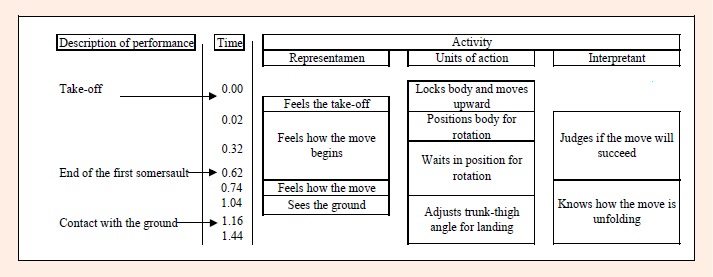
Location and description of the stream of activity of TU1.
Figure 2.
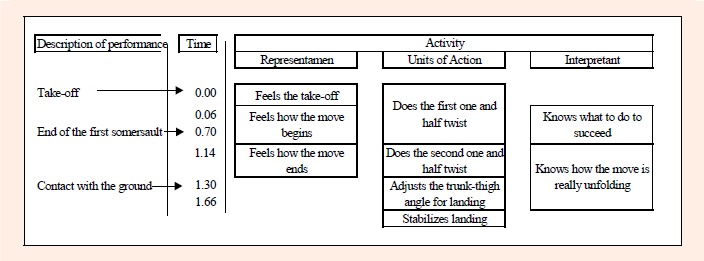
Location and description of the stream of activity of TU2.
Figure 3.
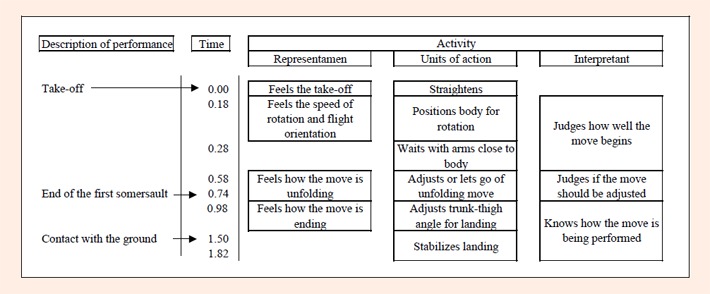
Location and description of the stream of activity of TR1.
Figure 4.
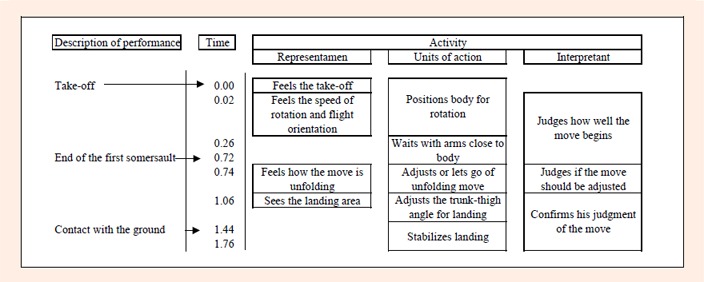
Location and description of the stream of activity of TR2.
Figure 5.
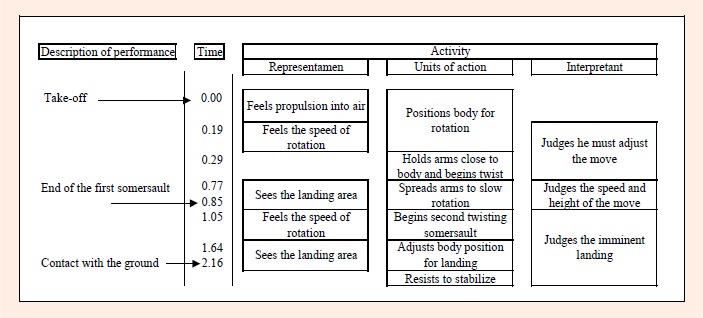
Location and description of the stream of activity of AC1.
Figure 6.
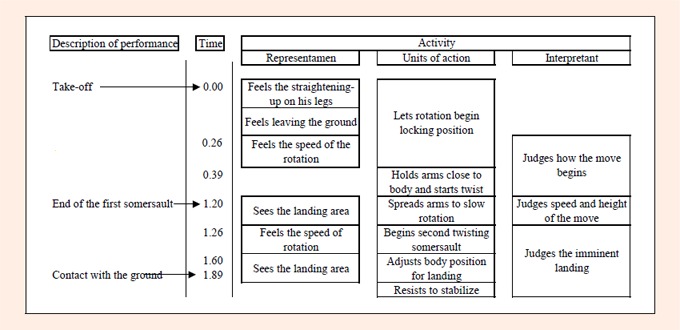
Location and description of the stream of activity of AC2.
Differences and convergences between performers related to the action units, representamens and interpretants
The results showed that TU1 and TU2 organized their rotations in two action units: “positions body for rotation ”and either “waits in position for rotation ”or “does the first (and the second) one-and-a-half twist”. For TR1 and TR2, a third unit was added at the end of this succession, labeled “adjusts or lets the move go”. For AC1 and AC2, this rotation was organized in four units: “lets the rotation begin”, “starts the twist”, “spreads arms to slow the rotation ”and “performs the second part of the twist”. For all performers except TU1, the rotations ended with action units labelled “adjusts the trunk-thigh angle for landing ”and “stabilizes the landing”. For TU1, the activity began with an action unit labelled “moves the body upward ”before beginning the twists. The analysis of the evolution in the representamen demonstrated that all the athletes began their performances with “feels the take-off”. The tumblers’ representamens were then divided into feelings of the beginning and the end of the move. The trampolinists discriminated these feelings with attention to the speed and orientation of the rotation at the beginning of the move. They then switched to feelings of the unfolding rotation until its ending. The skiers’ representamens were organized as a double alternation of feelings about the rotation and visualization of the landing area.
The evolution in the tumblers’ interpretants was divided into two steps that corresponded to an initial estimation of the success of the jump which was then transformed by knowledge acquired during its unfolding. For the trampolinists, this evolution in the interpretant concerned a series of judgments about the beginning and unfolding of the jump and concluded with final knowledge that confirmed these judgments. For the skiers, these judgments during performance were based on accurate information concerning the speed and height of the move. These judgments concluded with an estimation of the imminent landing.
The relationship between these components
The results showed that the activity of all the athletes could be characterized by a beginning period consisting of actions to initiate the rotation (i.e., “positions body for rotation”, “does first one-and-a-half twist”) associated with a feeling of the move related to the take-off. These feelings, which rapidly became specific for the athlete (i.e., beginning of the move for tumblers, speed and orientation for trampolinists, speed for acrobatic skiers), were associated with interpretants that helped the performer to estimate how the move had begun. A new action unit that consisted of waiting (i.e., “waits in position for rotation with arms close to body”) corresponded to this knowledge (except for TU2, who did not mention this waiting period). At this point, sport-related differences in the relationships between components could be identified in the athletes’ course of action. For the tumblers, the activity shifted directly to the final period of the move, with actions promoting the landing (i.e., “adjusts trunk-thigh angle”) associated with representamens related to the end of the move (i.e., “feels the end”, “sees the ground”) and interpretants that defined their knowledge about the success of the move. This final period was noted for the trampolinists and skiers, but they first displayed additional periods of activity. The trampolinists had a period of actions to adjust the rotation or let it go on, depending on their judgment in the beginning period. At this moment, the trampolinists’ interpretant was needed to modify the course of the move in order to make their jump succeed. This knowledge provided complementary information for the final judgment on the move. For the acrobatic skiers, an alternation in the activities of examination and execution of the move could be observed. First, they spread their arms, looked at the ground and judged the course of the move. They then engaged the next part of the move with the action unit that drove the second part of the rotation, a representamen concerning the rotation speed, and an interpretant related to the possibility of landing well. Hence, the knowledge they gained during these alternating periods was built on a step- by-step regulation-examination of the rotation.
Discussion
The aim of this study was to compare elite athletes’ activity as they performed the same acrobatic move in order to identify processes constructing meaningful time. The results showed that the athletes’ activities displayed typical action units, representamens and interpretants during their acrobatic performances. However, although a sequence of components of activity seemed to organize the unfolding of all performances by progressively informing the athletes about the state of the evolving situation, several sport-related distinctions were identified. The comparison of the athletes’ activities showed that the tumblers’ organization of activity was the simplest, with activity and meaningful time segmented into three principal periods: the beginning, the waiting period and the end of the move. In contrast, the trampolinists and acrobatic skiers showed more complex organization, with more segments of activity containing a greater number of actions (i.e., adjustments, spreading arms to slow rotation) in order to collect more information about the performance (i.e., speed, height) and to build a more accurate judgment on the course of the move. These results indicated that the athletes did not perform their moves in the same experienced world. The tumblers’ activity was based on a reduced process of information-gathering and incomplete information, whereas the trampolinists and acrobatic skiers were able to gain more information during performance, which allowed for greater regulation.
The results also indicated that the acrobatic activity (in all three sports) displayed elements of meaningful time that were common to all, as well as elements that were specific to each sport. Shared elements of organization were the three minimal parts of activity identified in all the acrobatic performances (i.e., initiates rotation, waits, organizes landing). Specific elements of organization were identified from the components of activity that certain performers added (i.e., trampolinists and acrobatic skiers). Although all athletes performed the same leap, they organized their meaningful time differently, in relation to their specific sport. The duration during flight for implementing differing periods and components of activity is the best potential explanation of the enrichment of activity observed in the trampolinists and acrobatic skiers compared with the tumblers. All athletes displayed different periods of activity in close relation to the possibilities offered by the flight time in their respective sports, in order to perform the leap well. Flight time was organized into meaningful time, comprising both cognitive and physical activity. These results reflect the “enactive ”property of acrobatic activity (Bourgine and Stewart, 2004; Varela et al., 1991) and the intelligent use of time during performance (Kirsh, 1995).
The comparison of the links between components of activity revealed four types of activity related to the organization of meaningful time during flight:
The first activity, which was termed “waiting to feel what is happening in the present moment and estimating the future”, linked the action of waiting to the collection of feelings about the present and to the construction of knowledge that would allow the activity to unfold during the next time period. For example, the results indicated that at the beginning of flight, the athletes were unsure of how well the jump had been initiated. Their activity thus consisted in waiting for a brief instant (i.e., “waits”) so that they could collect feelings to build an estimation of how well the jump had begun and how it was likely go on during the next time period.
The second type of activity, which was characterised by “present feelings and past knowledge of the unfolding jump”, organized action and feelings in relation to the present but was constrained by knowledge of the past unfolding of the performance. For example, the results showed that, at the end of the performance, the activity of all the athletes consisted of adjusting the body position for landing in relation to visualizing the landing area. This type of activity was also linked to knowledge about the unfolding of the performance, which indicated, for example, the relative urgency of displaying this specific activity. Thus, the feeling-acting coupling was constrained by knowledge of how this part of the activity should unfold in relation to past events.
The third type of activity was based on an “incomplete but sufficient estimation of future action initiated by a specific unfolding feeling”. It displayed actions engaged in relation to a rough estimation of the following performance period and initiated the focus on present feelings. For example, the results showed that during the second somersault of the leap, the acrobatic skiers’ activity consisted of “launching ”the twist. This action would not have been possible if the athletes had not known whether the performance could be achieved. This estimation of a realizable future initiated action and allowed a focus on the feelings related to the twist (e.g., speed or a locked position) and not on other aspects of the performance (e.g., visualizing the landing area in the case of an estimation of a low chance of success).
The fourth type of activity was “to collect feelings and check estimations of the past and future”. It displayed actions of collecting feelings that would determine the validity of knowledge acquired during the past. For example, the results indicated that between the first and second somersaults, a part of the acrobatic skiers’ activity consisted of spreading their arms. This action opened up the possibility of accurately visualizing the landing area and made it possible to check the validity of the past estimation of the performance. This “link ”enabled the possibility of engaging in another period of activity.
The activity observed during these performances was a segmentation of “meaningful time”. The complexity of such performances (720° of somersault and 1080° of rotation during a flight time between 1.16 - 2.16 s) was reduced by a process of timed “organization”. Each of these segments represented a step that opened up a new possibility for the performance. These results could be interpreted as a process that displayed different “steps ”corresponding to a meaningful time for the activity (Kirsh, 1996), - a device for stabilizing a process and reducing the degree of uncertainty. Each step was related to particular actions, feelings and thoughts that allowed the unfolding of the activity and increased its overall effectiveness in relation to the specific sport. The performers used embodied actions, feelings and thoughts about the unfolding leap to mark their actions in time and space. This activity progressively built its own levels of organization, assigning different properties to each type of link between components of activity: some links were aimed at assessing, others at transforming, others at verifying. These links gave meaning to the co-ordination between cognition and physical action (Clancey, 1997; Hauw et al., 2003; Kirshner and Whitson, 1997). Acrobatic activity is displayed in an undetermined horizon of results and events. With the appropriate use of meaningful time, the athletes tested and reduced the possibilities of what could occur. Understanding a performance in these terms suggests that expertise can be conceived as a dynamic activity that allows the athlete to make reasonable guesses as to where s/he is in space and time, even though this may not be totally accurate.
Conclusion
The present study showed that the activity that occurs during acrobatic performance depends on the possibilities offered by cognition and analysis. A better understanding of these processes should help coaches to determine the particular direction(s) of activity that acrobatic training should enhance so that athletes can perform more effectively / efficiently, within their specific sport.
Acknowledgments
This study was supported by a grant from the French Ministry of Sport, the French Gymnastics Federation and the French Ski Federation.
Biographies

Denis Hauw
Employment
Ass. Prof. at the Faculty of Sport Sciences of Montpellier, France.
Degree
PhD
Research interests
The dynamics and situated activity of elite athletes.
E-mail: denis.hauw@univ-montp1.fr
Marc Durand
Employment
Professor at the University of Psychology and Education of Geneva, director of the Form’Action laboratory and coordinator of the Educational doctoral school of occidental, Switzerland.
Degree
PhD
Research interests
Activity oriented adult education.
E-mail: marc.durand@pse.unige.ch
References
- Bourgine P., Stewart J. (2004) Autopoiesis and cognition. Artificial Life 10, 327-345 [DOI] [PubMed] [Google Scholar]
- Bruner J. (1990) Acts of meaning. Harvard University Press, New York [Google Scholar]
- Clancey W.J. (1997) The conceptual nature of knowledge, situations and activity. : Expertise in context: Human and machine. : Feltovich P., Ford K.M., Hoffman R.R., Cambridge: MIT Press; 247-291 [Google Scholar]
- Greeno J.G. (1998) The situativity of knowing, learning and research. American Psychologist 53, 5-17 [Google Scholar]
- Hauw D., Berthelot C., Durand M. (2003) Enhancing performance in elite athletes through situated-cognition analysis: Trampolinists’ course-of-action during competition. International Journal of Sport Psychology 344, 299-321 [Google Scholar]
- Hauw D., Durand M. (2004) Elite athletes’ differentiated action in trampolining: A qualitative and situated analysis of different levels of performance using retrospective interviews. Perceptual and Motor Skills 98, 1139-1152 [DOI] [PubMed] [Google Scholar]
- Hauw D., Durand M. (2005) How do elite athletes interact with the environment in competition? A situated analysis of trampolinists’activity. European Review of Applied Psychology 55, 207-215 [Google Scholar]
- Hauw D., Durand M. (2007) Situated analysis of elite trampolinist’s problems in competition using retrospective interviews. The Journal of Sport Sciences 25 (2) , 173-183 [DOI] [PubMed] [Google Scholar]
- Kirsh D. (1995) The intelligent use of space. Artificial Intelligence 73, 31-68 [Google Scholar]
- Kirsh D. (1996) Adapting the environment instead of oneself. Adaptative Behavior 43 (4), 415-452 [Google Scholar]
- Kirshner D., Whitson J.A. (1997) Situated cognition. Social, semiotic and psychological perspectives. Lawrence Erlbaum Associates, Mahwah: New Jersey [Google Scholar]
- Peirce C.S. (1931-1935) Collected papers of Charles Sanders Peirce. Harvard University Press, Cambridge [Google Scholar]
- Sève C. (2004) Elite athletes’ sensitivity to context: The case of a change in scoring system in table tennis. Perceptual and Motor Skills 99, 1274-1276 [DOI] [PubMed] [Google Scholar]
- Sève C., Saury J., Ria L., Durand M. (2003) Structure of expert players’ activity during competitive interaction in table tennis. Research Quarterly for Sport and Exercise 74, 71-83 [DOI] [PubMed] [Google Scholar]
- Theureau J. (1992) Le cours d’action: analyse sémiologique. Essai d’anthropologie cognitive située [The course-of-action: semiological analysis. Essay on situated cognitive anthropology]. Peter Lang, Berne. (In French) [Google Scholar]
- Theureau J. (2003) Course-of-action analysis and course-of-action-centered design. : Handbook of cognitive task design, : Hollnagel E.Mahwah, New Jersey: Lawrence Erlbaum Associates; 55-81 [Google Scholar]
- Theureau J., Jeffroy F. (1994) Ergonomie des situations informatisées [Ergonomics of computerized situations]. Octares, Toulouse. (In French) [Google Scholar]
- Van Someren M.W., Barnard Y.F., Sandleberg J.A.C. (1994) The think aloud method: A practical guide to modeling cognitive processes. Academic Press, London [Google Scholar]
- Varela F. J., Thompson E., Rosch E. (1991) The embodied mind: Cognitive science and human experience. MIT Press, Cambridge, MA [Google Scholar]
- Vermersch P. (1999) Introspection as practice, : The view from within, : Varela F.J., Shear J., Thorverton: Inprint Academic; 17-42 [Google Scholar]


